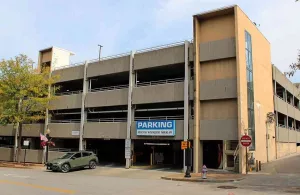Amid a construction (and demolition) boom, Philly announces steps to beef up historic preservation
Published by John on
Mayor Jim Kenney on Thursday unveiled steps that his administration and City Council plan to take to better protect some of Philadelphia’s oldest and most interesting buildings, nearly two years after convening a task force to study historic preservation.
Surrounded by Councilman Mark Squilla, preservation leaders, and task force members, Kenney explained wide-ranging regulatory changes that his administration plans to make to bolster preservation, while Squilla announced that he would introduce legislation to incentivize preservation-minded development. Among the city’s most significant plans: establishing a citywide survey to document Philadelphia’s historic properties, creating an “index” of non-historically designated buildings that cannot be demolished until there is a review, and introducing a zoning bonus for developers who contribute to a new Historic Preservation Fund.
“These actions will help preserve what makes Philadelphia unique — our historic assets,” Kenney said at the news conference. “… Whether you live in Germantown, Frankford, Girard Estates, or in almost any neighborhood in our city, you are surrounded by history from buildings to parks. We need to appreciate and preserve that.”
The announcement in City Hall comes a few months after Kenney’s 33-person historic preservation task force delivered its draft report for public comment. Over the course of nearly two years, the diverse group — which included fierce preservationists and pro-development representatives — studied and argued about the best preservation practices. Many of the changes that Kenney and officials announced came from the task force’s December report, which culminated after 15 meetings, including 11 open to the public. A final version of that report was issued Thursday.
The task force was often criticized for moving too slowly and for reported infighting — the group’s chairman, Harris Steinberg, said Thursday that the task force’s views “did not always align” — especially as a number of prominent historic buildings continued to fall. Philadelphia demolitions hit a record high in 2018, PlanPhilly reported, though many were not historic.
Still, high-profile examples of demolition of historic buildings abound, including the 19th-century Christ Memorial Reformed Episcopal Church in West Philadelphia, which was recently purchased by Alterra Property Group, cofounded by Leo Addimando, a member of the preservation task force. Representatives from another church, one in South Philadelphia with ties to Frank Furness, recently applied for a demolition permit as well.
Thursday’s announcement marks a delivery from Kenney on a 2015 campaign talking point just weeks ahead of the May 21 primary, in which Kenney faces two Democratic challengers. Four years ago, Kenney spoke about bolstering the city’s historic preservation efforts, including having “a better roster of our significant buildings,” he told PlanPhilly in 2015. Kenney later increased the Historical Commission’s budget by $96,000, allowing it to hire two more staffers. He also has spoken out against developments that he opposed, including Toll Brothers’ plans to build a condo tower on Jewelers Row, which in 2016 he called “deeply disturbing.”
Still, Toll and other developers have tried to push forward with demolition plans, and Philadelphia lost a number of properties — including the Christian Street Baptist Church in Bella Vista, the Society Hill Playhouse, and Mount Sinai Hospital — in recent years. According to the final report issued by the task force, just 2.2 percent of Philadelphia’s buildings are listed on the city’s historic register, compared with an average among 50 cities of 4.3 percent.
The success of Kenney’s preservation initiatives will largely hinge on how quickly his administration and City Council can work — and how they can find the funding to do it. At the news conference, officials said the timelines for some initiatives are still being worked out, including the idea to create an “index” of potentially historic properties that would be automatically flagged for review when a demolition permit is requested.
“Everyone knows the property in their neighborhood that they think is threatened,” said Dominique Hawkins, a preservation architect and vice chair of the task force. “So what the intent will be is to assemble this list of properties that merit historic preservation on their face.”
Squilla said the city chose to focus on priorities that “we thought we could get through quickly and easily and less controversially than others that may give us some hiccups and get people against the idea.”
“The last thing we want to do is get an uproar of opposition,” Squilla said. “And so we thought if we could get some of these early wins in, we could build some momentum to then go after the tougher ones.” He added that some of the priorities are “still not going to be easy.”
The task force’s report highlights many challenges, from disconnected city agencies to a lack of staffing to outdated databases. According to the report’s summary, historic resource information is kept in paper files or in a limited electronic database, meaning there is “no current digital inventory management system to collect, track, and maintain historic resource data.”
That scattered record-keeping has been problematic amid the city’s heightened development boom, which has been exacerbated by both Philadelphia’s resurgence and a 10-year tax abatement on new properties and building improvements. Some observers hoped the city would address the possibility of a tax-abatement program geared toward historic preservation. However, the report does not recommend changing the current abatement.
Still, Kenney’s plan does include historic preservation incentives for developers, which Squilla will introduce to City Council. In addition to introducing zoning bonus legislation, he plans to introduce a bill that would reduce parking requirements for historic buildings that are redeveloped and preserved. Another bill would increase the ability for developers to redevelop properties “by right” — meaning under their current zoning designation — if they are “special purpose” historic buildings such as churches and schools.
According to the task force’s report, this would help with the redevelopment of properties including churches and theaters, which tend to be more difficult to adapt.
In addition, Squilla, who represents the city’s First District, which includes Old City, plans to introduce a bill that would create two new types of historic districts for neighborhoods. The report recommended that one district would be more flexible than current historic districts, with a less rigorous demolition review process. This, according to Paul Steinke, executive director of the Preservation Alliance for Greater Philadelphia, could assist “middle neighborhoods,” which may want to see properties preserved, including their own homes, without having stricter regulations attached.
The task force’s report does address incentives for individual property owners, too, though many were not discussed at the Thursday news conference. The report, for example, recommends implementing a property assessment formula that recognizes the impact of historic preservation.
“Historic designation places restrictions on a property, and the presence or absence of a restriction is a property characteristic in the same way the presence or absence of a garage is a property characteristic,” the report stated.
Kenney’s priorities also include better honoring the city’s archaeological artifacts and improving the predictability and transparency in the historic designation process. To do that, officials said, the city hopes to post clearer guidelines so that residents can better understand what is required to nominate a property.
“I think a lot of people were concerned at the outset that it had a pretty long timeline, but it’s over, so let’s digest the recommendations and get started,” Steinke said after the announcement. “Would it have been better to get started a year ago? Sure. But to coalesce all these different points of view and to incorporate all their input does take time.”







